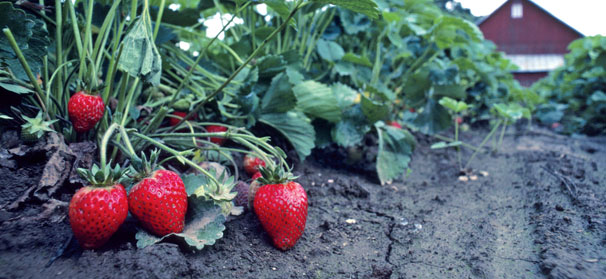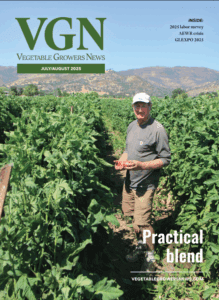
Jun 16, 2011Too much water can be bad for strawberries
Water is usually a relatively inexpensive input in fruit production, and many producers have the luxury of supplying more water than is really necessary to obtain a full crop. This is particularly true in the Northeast, where ample water is usually available – especially in spring. However, excessive irrigation (or overhead frost protection) can contribute to nutrient leaching and disease development.
For example, researchers in Norway examined four levels of supplemental irrigation and a control over two years. In one year, there were no differences in yield among treatments, and in another year the lowest yields were in the two treatments receiving the most supplemental irrigation, corresponding to low nitrogen levels in leaves. Clearly, water supplied in excess can be as detrimental as insufficient water.
How much water?
In strawberries, a critical stage of growth is the establishment period of the transplants. For about two weeks, newly set transplants are susceptible to even mild water stress. This vulnerability is mainly because plants have not developed a good fibrous root system with fine root hairs for water absorption. In the fruiting year, yield reductions of 33 percent and size reductions of 17 percent have been documented under only moderately dry conditions without irrigation.
Strawberries grown on plastic beds in warm climates require about 18 inches of water over a 200-day growing season – after they have become established. This is the equivalent of about 22 gallons per plant per season. (Actual water use by the strawberry plant is about 55 percent of this amount; more water is applied than what the plants actually use because of losses due to leaching, evaporation, inefficient application and an inadequate ability to assess water requirements on a daily basis.) Matted-row growers often ensure that a minimum of 1 inch is applied as irrigation or rainfall during the growing season, mainly to replace soil moisture lost to evapotranspiration.
How do deficits affect growth?
Water stress can interfere with photosynthetic activity and reduce the potential growth of the plant. Several experiments have been conducted to measure the responses of specific vegetative plant parts to water deficit stresses. Root systems of strawberry are affected by water shortages, with the root/shoot ratio increasing in response to water stress. Reductions in the number of leaves, runners and crowns also have been observed when long and frequent droughts are experienced.
The rate of leaf expansion is greatest during a five-hour period beginning one hour before sunset.
Water-stressed plants have a reduced rate of leaf expansion during this period, and these differences can accumulate over the season until well-watered plants have twice the leaf area as non-irrigated plants. With only moderate water stress, leaf area can be less than half that of the well-watered plants after a four-month period. A portion of the difference in leaf area can be attributed to leaf death under droughty conditions, especially of older leaves.
The older the leaf, the more prone it is to senescence should stress conditions occur. Furthermore, under moderate water stress, younger leaves are able to maintain higher relative water content than older leaves.
How do deficits affect fruiting?
Water deficit has been shown to cause fruit yield reduction by decreasing flower numbers, fruit set, numbers of fruit per plant and fruit size. Differences in yield and fruit quality between well-watered and stressed plants have been demonstrated by many studies on various cultivars and in various production systems.
Numbers of fruit per plant can be decreased by more than 30 percent, and total fruit production can decline by about 80 percent when plants are severely stressed from the beginning of the growing season.
Accelerated ripening and smaller fruit size occur in water-stressed strawberries. Surecrop has a larger root system and is more tolerant to drought than Raritan with a much smaller root system. However, when water is not limiting, Raritan has higher yields, suggesting that there is a physiological cost associated with maintaining a large root system.
Is irrigation required?
The measurement of a crop’s water needs in the field usually is estimated with tensiometers, electrical conductance tools, weather data or pan evaporation. Usually, these tools are used to trigger supplemental irrigation when soil moisture falls below a predetermined level.
Researchers achieved the maximum yield response when soil moisture was kept above 65 percent of field capacity in the top 60 centimeters of the soil. However, obtaining maximum yields may not be equivalent to achieving economically optimal yields, especially in areas where irrigation costs are high. Tensiometers can be used to assess field capacity of the soil, and take the guesswork out of estimating irrigation needs based on rainfall or how wet the soil feels. A rule of thumb is to not let the soil moisture fall below 50 percent field capacity.
By setting a bucket over a strawberry plant in the evening and examining the plant the next morning, one can estimate the need for irrigation by seeing if beads of water have formed on the edges of younger leaves during the night. Guttation is a phenomenon by which xylem sap is exuded through the pores of the hydathodes in the leaves, as the result of root pressure. Guttation usually takes place at night when transpiration is low and humidity and soil moisture are high. Research suggests that guttation only occurs in well-watered plants.
How to apply water?
Researchers have found that drip irrigation is much more efficient (requiring about 50 percent less water) than overhead for meeting the water requirements of the strawberry. Studies suggest that the use of water in many strawberry fields is not optimized. Evidence of this inefficiency was found in a comprehensive survey of strawberry growers in the Huelva region of Spain. Although soil type, cultivar and climate were the same for these growers and 78 percent of them considered their water use sufficient, the variation in water use/area was as much as 96 percent for some irrigation systems. These researchers calculated an index of uniformity, with 100 percent indicating that each emitter in the field was providing the same amount of water per unit time.
Within fields, the irrigation uniformity index averaged 49 percent, despite the fact that the majority of systems were only between three and five years old. These data suggest that growers are not optimizing their use of irrigation water, partially because of uneven distribution of water within a field.
In a nutshell, you will need to ensure that the irrigation system is up and running at planting, since young plants are most susceptible to drought stress. Develop a method of assessing plant water needs, whether it be using tensiometers, looking for guttation or using electrical conductivity meters. Finally, determine if your irrigation system is applying water uniformly. If not, make necessary adjustments. Drip irrigation systems tend to be more uniform and efficient than overhead systems.
By A.H. El-Farhan, Marvin Pritts, Cornell University
















